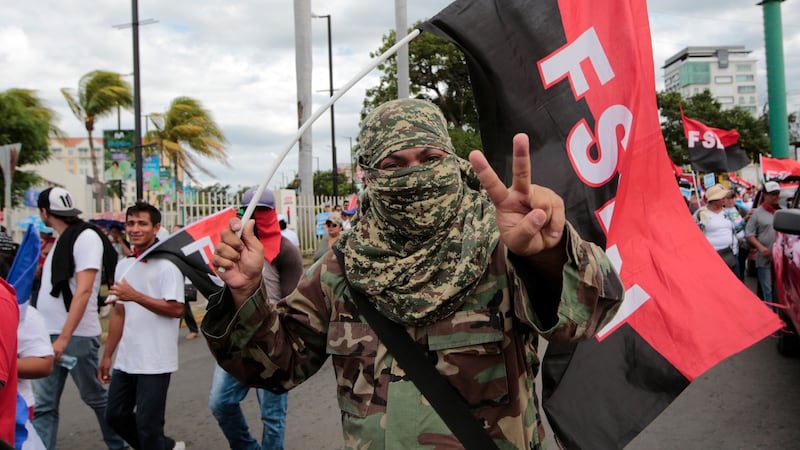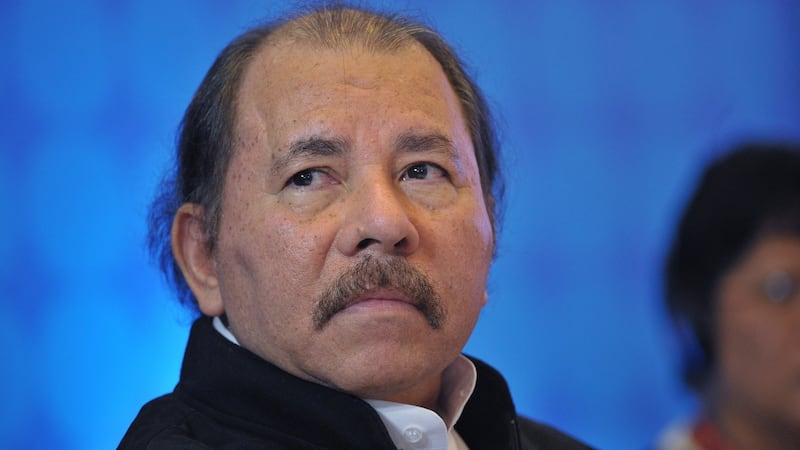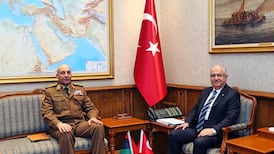Juan José is digging a latrine on the small, 8m by 25m plot the government of Daniel Ortega has given him to build a house. It is prime real estate, across from a smart golf club on the outskirts of the Nicaraguan capital, Managua. Given that he is out of work, he is particularly happy not to have to pay rent.
He has long considered himself a supporter of the Sandinista National Liberation Front (FSLN) – the one-time revolutionary movement that has led an elected government for over a decade. But now he has qualms. The land where he and others are building houses, many sporting the red and black Sandinista flag, has been commandeered by the government – probably as an act of political revenge – since the start of an uprising four months ago.
“We were okay with the government before,” the 47-year-old former hardware store employee says, leaning on his shovel. But now, “I’d prefer a president who doesn’t kill us”.


Juan José’s cutting assessment is a reference to the brutal repression of protests by masked paramilitary forces loyal to the government in which as many as 448 people have died since protests erupted on April 18th. That has prompted him, like many other Nicaraguans, to undertake a dramatic rethink of their support for the leftist leader.
Ortega was once the face of the romantic rebels who overthrew US-backed strongman Anastasio Somoza in 1979 and fought the US-sponsored Contra counter-revolutionaries in the 1980s. Since returning to office in 2007, however, Ortega has concentrated power to such an extent that he is beginning to resemble the dictator he replaced, say critics.
Friends are few. Historic ally Cuba has long lost its influence. Venezuela, which supplied millions of dollars in cheap oil and aid over the past decade, is in desperate straits. Much of the business community, which had become a key pillar of support for the one-time leftist radical, has turned on him.
Barricades
Once a self-professed man of the people, providing power, roads, internet, education and healthcare in the second-poorest country in the western hemisphere after Haiti, Ortega has been Nicaragua's president for 22 of the past 39 years. But now he has literally dug in – barricades surround his official residence – together with his wife Rosario Murillo, a writer of mystical poetry who is also his vice-president.
Despite demonstrations demanding his exit, including one snaking as long as 6km, Ortega (72) has vowed to stay until scheduled elections in 2021, even taking to CNN and Fox to broadcast his intentions. With leftist icons Fidel Castro of Cuba and Venezuela's Hugo Chávez dead, Ortega is the last in a generation of Latin American revolutionaries still clinging to power.
"Before April, you could have argued that he was a benign autocrat," says Arturo Cruz, a former Nicaraguan ambassador to Washington, now a professor at Incae Business School in Costa Rica. "If he had known when to go, he'd have gone down as a transformer. He risks being exactly like Somoza – whatever good things he achieved will be erased by being a bad autocrat."
Henry Ruíz, a former member of the military junta co-ordinated by Ortega that ruled after 1979, puts it more bluntly. “He’s gone from being an idealistic Sandinista revolutionary to being a consummate fascist,” he says.
Ortega’s career is like a play in four acts. From teenage rebel to wily political operator to strongman, he has reinvented himself in every one.
Revolutionary junta
In his first incarnation, he was an idealistic young Sandinista who took up arms to fight the Somoza regime. Arrested for his role in an armed robbery and tortured during seven years in jail, he was freed in 1974 as part of a hostage swap. After guerrilla training in Cuba, he rose to be the head of the nine-man revolutionary junta that took power in Nicaragua in 1979 when the Somoza regime was overthrown "because he was the one who made the fewest waves", says Sergio Ramírez, his vice-president in the 1980s.
Within two years, the country was plunged into a civil war with Contra counter-revolutionaries that was to last most of the decade. Nonetheless, in 1984, Ortega was formally elected president and “lived travelling the country, meeting people”, says Luis Carrión, another of the nine junta commanders. “It was like he was on a permanent campaign, so people gradually identified the revolution with him.”
With the economy wrecked by war, a US trade embargo and hyperinflation that climbed to 64,000 per cent in 1991, Ortega lost the 1990 elections to Violeta Barrios de Chamorro.
For Ortega, a short, moustachioed man of spartan tastes – his Mercedes is one of few luxuries – it was also a time of personal scandal after a stepdaughter accused him of raping her from the age of 11. Both he and her mother, Murillo, denied the allegations.
In defeat, Ortega went about reinventing himself again, breaching political differences to forge a political pact with liberal president Arnold Alemán to rewrite electoral rules helping him regain – and retain – power. “He was a first-rate opportunist,” says Enrique Sáenz, a former opposition deputy.
After two successive defeats, he won in 2006 with just over 38 per cent. “He came back intending never to leave,” says Ramírez, who attributes his rise from guerrilla to strongman to “unbridled ambition ... a lack of scruples and a tonne of money from Venezuela”.
Cosy rapport
The president sworn in before an audience including Fidel Castro and Iran's Mahmoud Ahmadinejad in 2007 was a very different Comandante Daniel to the young revolutionary of three decades earlier.
Despite his socialist invective, he enjoyed a cosy rapport with the private sector. Until this year’s protests, business leaders turned a blind eye to his increasing authoritarianism in exchange for tax breaks and little interference in their businesses.
At the same time, says Elvira Cuadra, a political analyst at a think-tank in Managua, "when he came into office in 2007, he knew his legitimacy was very low. So he began preparing monitoring and control apparatus to suffocate and control dissent". The police and military came under the direct control of the president.
In what could end up as his fourth and potentially final act, Ortega’s government has mimicked many features of the authoritarian regime he once fought against.
The crunch came when oil prices collapsed and Venezuelan aid started to slow, almost drying up altogether by last year. Ortega was forced to cut back some social programmes. Setbacks began to mount. Last November, the government had to backtrack on plans to increase vehicle tax by as much as 3,000 per cent.
The following month it was forced to scrap a plan to declare celebrations of the Virgin Mary as part of the national cultural heritage. Outraged, the church had considered it tantamount to trying to nationalise Nicaragua’s top religious festivities.
Then came an increase in electricity bills in March and the botched handling of a fire in a nature reserve in April. Attempts days later to push through a reform that would have increased pension contributions were the final straw. Ortega was forced to U-turn, but protests were already spiralling.
The crackdown from paramilitary forces – used as shock troops, according to Cuadra, the political analyst – was swift and indiscriminate. One 15-year-old boy died after being shot in the neck while taking water to protesters. An attempt at dialogue in May – at which student leader Lesther Alemán told Ortega “this is a negotiation to discuss your exit” – swiftly collapsed. But the killing continued. Snipers fired on a march on Mother’s Day in May, killing 19 and in July, gunmen besieged a church where protesters had sought refuge.
Youtful protesters
Since mid-July, Ortega has regained some control after paramilitaries broke up roadblocks that had symbolised popular defiance of the regime.
Yet there are eerie throwbacks to the turbulent 1970s. While the youthful protesters have ripped up paving stones to mount barricades as the FSLN did 40 years ago, Ortega has followed Somoza in cracking down on protests, spurning diplomatic efforts and refusing early elections. He has described the unrest as a coup attempt by the “extreme right” and blamed the demonstrators for the violence.
While Somoza, the last of a dynasty that ruled Nicaragua from 1937 to 1979, eventually agreed to surrender power, Ortega, by contrast, is widely seen as grooming Murillo – his wife of four decades and power behind the throne – to replace him.
Further attempts at dialogue with an opposition alliance of students, civil society groups and business leaders, brokered by the church, has collapsed.
At the same time, Nicaragua’s imploding economy has forced the government to rush through savage budget cuts and ready a domestic bond issue to stabilise the financial system. The monthly economic activity index crashed 12 per cent in June from the same month in 2017, according to the central bank. Tourism, an economic mainstay in the country of six million people, has ground to a halt.
"I don't think Daniel Ortega has the ability to recover governability, or the economy," says Mario Arana, a former central bank chief and finance minister. "We have a lot of external volatility that can strangle us faster than you think."
A regime that had once looked inviolable now looks vulnerable.
Unlike Venezuela, Nicaragua has no oil to keep it afloat and its economy – which exported $3.3 billion to the US last year – is exposed to the threat of additional sanctions from Washington. The US has already used the Global Magnitsky Act to sanction key regime figures and some US members of Congress are pushing for the measures to be extended to some of the Ortega children.
The US Senate is considering legislation that would cut off loans from multilateral lenders. "Daniel Ortega can't govern amid hostility from the US," says Ramírez, his former vice-president.
Impasse
From Washington’s point of view, the risk is that instability in Nicaragua snowballs into a broader security problem that undermines even further the stability of the region, already home to brutal gangs, a major transit route for drugs and a source of illegal migrants.
"The biggest challenge and threat is that the paramilitaries turn into common criminals," says Roberto Cajina, an independent security consultant and former government adviser.
For now, with relative calm restored, Nicaragua is at an impasse. An old-style Latin American military coup looks unlikely as the army has remained studiously aloof from the crisis.
Even if dialogue were to resume and Ortega were to agree to leave office, the opposition worries he could try to retain a power base through FSLN deputies. There are plenty of reasons for Ortega to resist pressure to go into exile – not least because he is aware that after Somoza fled to Miami then Paraguay, he was murdered.
“The only possible exit to this charade is dialogue and a reasonable negotiation,” says a former official and one-time Ortega adviser. But, from the government’s point of view: “The issue is whether the opposition is ready to oblige.”
Many expect the current lull to be the calm before another violent storm.
“It looks like it will take some time,” says Sáenz, the former opposition deputy. “The water is rising, but it hasn’t reached his nose yet.”
Nicaragua timeline
1937 Anastasio Somoza García elected president. A 42-year family-run dictatorship begins
1961 Sandinista National Liberation Front (FSLN) founded, named after 1930s revolutionary murdered on Somoza's orders
1978 Murder of Pedro Joaquín Chamorro, opposition leader and editor of La Prensa newspaper galvanises uprising against Somoza
1979 Anastasio Somoza Debayle ousted. FSLN takes power. Daniel Ortega coordinates nine-man junta
1981-88 Civil war as US-backed counter-revolutionaries known as "Contras" battle FSLN
1984 Ortega elected president
1990 Violeta Barrios de Chamorro, widow of slain newspaper editor, elected president
2006 Ortega returns to power and is re-elected in 2011 and 2016
2018 Political crisis over social security reform erupts and swiftly turns into nationwide anti-Ortega protests – Copyright The Financial Times Limited 2018










